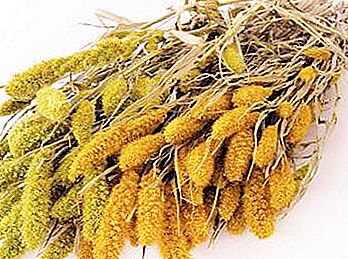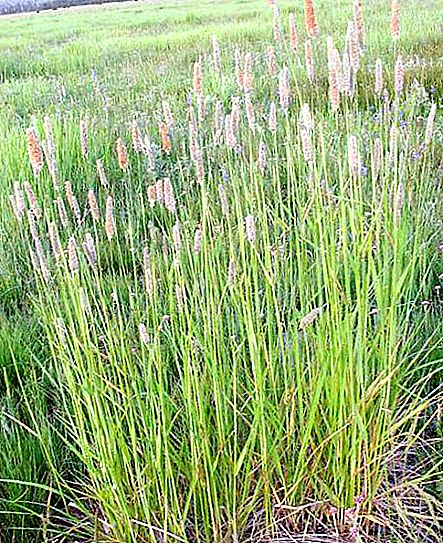The family of cereal (bluegrass) is numerous and includes more than 10 thousand plant species. Many of them are of great economic importance (rye, oats, wheat, barley, etc.). Some are medicinal, others are decorative, and some combine several features. In particular, meadow foxtail is widely used in folk medicine and in decorative gardening.
Botanical description of the plant
The plant is perennial, grassy, forms large loose sods. The rhizome is short, reaches a height of 50-120 cm, the leaves are flat, linear in shape, pointed, rough, green in color, sometimes with a bluish bloom, 4 to 10 mm wide. The inflorescence is characteristic of a family plant - panicle. Its length is 3-10 cm, and its width is 6-9 mm. Spikelets are elliptical in shape and collected in twigs of three or four pieces.

The foxtail meadow (family of cereals) blooms in June, bearing fruit in July. It is noteworthy that the plant belongs to morning cereals. Its flowering can be observed in the early hours - from 4-5 to 7-8 in the morning. The fruit is an ovoid, oblate-shaped caryopsis, 4-6 mm long, has small spikes. Fruiting occurs in the second year of growth, pollination occurs by the wind. In a herbage can grow in one place up to 10 years.
Habitat and distribution
Traditionally, the meadow foxtail plant is considered typical of the meadows of the northern part of Europe, which are its geographical homeland. However, at present it has spread everywhere, with the exception of the tropical zones. Very often in places of growth, it forms dense thickets with sodding of the soil. It grows equally well on marshy and wet meadows, dry lands, forest glades, riverbanks and lakes, pebbles, and is found along roadsides. It is the predominant plant in the grass stand on different-grained flood meadows, along with creeping wheatgrass, bluegrass, and shoot-bearing woodland.

Soil, the foxtail meadow, the description of which is given in the article, prefers loose, moderately moist, fertile, peat bogs and loams. It is resistant up to a month can tolerate prolonged waterlogging, for example, during flooding. However, salinization, stagnation of water and waterlogging, as well as severe droughts are fatal for him.
The chemical composition of the raw material and its procurement
The harvesting time for all wild cereals comes in the summer. Mowed grass at the initial stage is cleaned of rough particles, earth, dust, sieved. Then the cereals are dried outdoors in the sun or in the shade, but in a well-ventilated area. Stems and thin leaves can be stored in a dry place for up to three years. A meadow foxtail in one kilogram contains up to 25 g of protein, up to 70 mg of carotene, 0.7 g of phosphorus, 3 g of calcium and a total of about 0.23 feed units.

Pharmacological properties
From the point of view of official medicine, the plant has not yet been fully studied. According to scientists from Germany, it can be effectively used to treat arthrosis, rheumatic diseases, arthritis. It gives a warming and analgesic effect, the flavonoids contained in its composition help strengthen the walls of blood vessels and capillaries, and have a good effect on the activity of the cardiovascular system. Carotene increases the body's defenses and strengthens eyesight.
Foxtail meadow in folk medicine
Herbs treat a lot, and this is a proven fact. It is important in this matter not to neglect the advice of specialists and to know the measure. Foxtail, in particular, is used to apply external dressings that help reduce pain, relieve cramps, and relax and soothe muscles. For him, as well as for other cereals, the ability to improve the condition of the walls of blood vessels is characteristic. With rheumatism, dermatological diseases, vegetovascular dystonia, you can make herbal baths. In addition, a decoction is made from the plant, which helps with diseases of the bladder and kidneys, including cystitis.
Decorative use
The Foxtail genus includes more than 70 species of plants that are distributed around the world, except for tropical zones. There are 18 representatives on the territory of our country, one of them is used in landscape design for arranging green and smooth lawns.

The meadow foxtail is also used in solitary landings. For the formation of decorative bumps, variegated forms are chosen. The most common variety in the culture is Aureovariegatus (or Aureus). It differs erect, and by autumn, slightly drooping leaves of a golden hue with bright green stripes. In culture, it is stable, non-aggressive, reaches a height of 30 cm, flower stalks - 50-100 cm. Regardless of whether you cut or leave spikelets, the bush will turn green in the shade and maintain a yellowish color in the sun.





